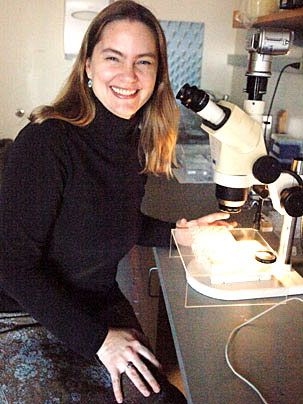MIT scientists have just learned another lesson from nature.
After years of wondering how organisms managed to create self-medications, such as anti-fungal agents, chemists have discovered the simple secret.
Scientists already knew that a particular enzyme was able to coax a reaction out of stubborn chemical concoctions to generate a large family of medically valuable compounds called halogenated natural products. The question was, how do they do it?
Chemists would love to have that enzyme's capability so they could efficiently reproduce, or slightly re-engineer, those products, which include antibiotics, anti-tumor agents, and fungicides.
Thanks to MIT chemistry Associate Professor Catherine L. Drennan's recent crystallography sleuthing, the secret to the enzyme's enviable prowess has come to light and it appears almost anti-climactic. It's simply a matter of the size of one of its parts.
"If an enzyme is a gun that fires to cause a reaction, then we wanted to know the mechanism that pulls the trigger," Drennan said. "In chemistry, we often have to look at 'molecules in, molecules out.' With halogenated natural products, though, we couldn't figure out how it happened, because the chemicals are so nonreactive. Now that we have the enzyme's structure and figured out how it works, it makes sense. But it's not what we would have predicted."
To make halogenated natural products, enzymes catalyze the transformation of a totally unreactive part of a molecule, in this case a methyl group. They break specific chemical bonds and then replace a hydrogen atom with a halide, one of the elements from the column of the periodic table containing chlorine, bromine and iodine. In the lab, that's a very challenging task, but nature accomplishes it almost nonchalantly. The trick involves using a turbo-charged enzyme containing iron.
A clue to how these enzymes operate emerged from a 2005 study by Christopher T. Walsh of Harvard Medical School, Drennan's collaborator and co-author of the study published in the March 16 issue of Nature. Looking at the SyrB2 enzyme that the microorganism Pseudomonas syringae uses to produce the antifungal agent syringomycin, he discovered it had a single iron atom in the protein's active site, the part responsible for the chemical reaction.
Drennan and her graduate student Leah C. Blasiak, who was first author of the study, crystallized SyrB2 and then used X-ray crystallography to discover the physical structure of the protein. The X-rays scatter off the crystal, creating patterns that can be reconstructed as a three-dimensional model for study.
Normally, iron-containing enzymes have three amino acids that hold the iron in the active site. In this enzyme, however, one of the typical amino acids was substituted with a much shorter one.
That smaller substitute leaves more room in the active site -- enough space for the halide, in this case a chloride ion, to casually slip inside and bind to the iron, without the grand theatrics chemists had anticipated. After the iron and the chloride bind, the protein closes down around the active site, effectively pulling the trigger on the gun.
"We were surprised," Drennan said. "The change in activity required for an enzyme to be capable of catalyzing a halogenation reaction is so radical that people thought there must be a really elaborate difference in their structures. But it's just a smaller amino acid change in the active site. Things are usually not this simple, but there's an elegant beauty in this simplicity," and it may be what gives other enzymes the prowess required for making other medicinally valuable halogenated natural products, too.
The research was partially funded by the National Institutes of Health.
A version of this article appeared in MIT Tech Talk on April 12, 2006 (download PDF).






